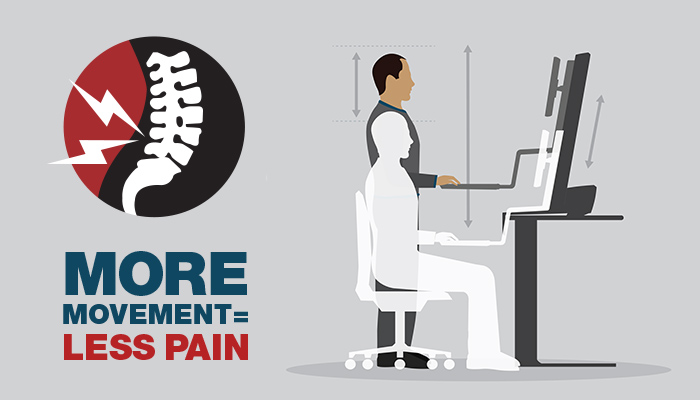Sit-stand desk users are 75% more likely to report pain-free days than those working at traditional seated [sit-only] desks.
This is just one of the encouraging findings in the study conducted by Stanford University, “Impact of a Sit-Stand Workstation on Chronic Low Back Pain Results of a Randomized Trial.” Published online in the Journal of Occupational and Environmental Medicine (JOEM) by Grant T. Ognibene, BA, Wilson Torres, BS, Rie von Eyben, MS, and Kathleen C. Horst, MD, the research concludes that low back pain may be improved by the introduction of sit-stand workstations.
The research confirms what our anecdotal evidence has told us, that the ability to change positions from seated to standing frequently throughout the workday gives workers some measure of relief from certain low back pain issues.
Back pain continues to be a key issue in terms of employee health and safety as well as a drain on business productivity in absenteeism, presenteeism, and increased worker’s compensation rates. It is estimated that 31 million Americans are experiencing back pain1, and the prevalence of global back pain is estimated to be around 23%2. Not only do businesses feel the impact of people out of the office dealing with pain, but workers themselves suffer from the physical and emotional stress of not being able to work as they would like.
The real good news here? Participants began to experience an improvement approximately 15 days after the sit-stand computer workstation was installed. And associated benefits included increased concentration: 95% of participants reported significantly lower back and neck pain, noting the pain was significantly less likely to interfere with their ability to concentrate.
“Our sit-stand workstations allow seamless movement between sitting and standing positions, offering users ergonomic comfort in addition to many other health-related benefits,” said Pete Segar, Ergotron CEO. “We will continue to build on our WorkFit product line with products like the WorkFit-T and WorkFit-TL to improve the health and productivity of the world’s office workers.”
The study, conducted onsite at Stanford, used a combination of 46 Ergotron WorkFit-S, WorkFit-A, and WorkFit-A Premium sit-stand workstations dependent on the worker’s desktop requirements.
This promising research is the first of what we hope many studies that explore some of the questions from this pilot: pain improvement happened slowly – would it continue to improve over a longer period? These folks already suffered from lower back pain – how part does adoption and use of sit-stand workstations play to prevent the onset of lower back pain? Would comprehensive ergo training in conjunction with SSW make for even greater improvement?
- Jensen M, Brant-Zawadzki M, Obuchowski N, et al. Magnetic Resonance Imaging of the Lumbar Spine in People Without Back Pain. N Engl J Med 1994; 331: 69-116.
- 2. Hoy D, Bain C, Williams G, et al A systematic review of the global prevalence of low back pain. Arthritis Rheum 2012;64:2028.



